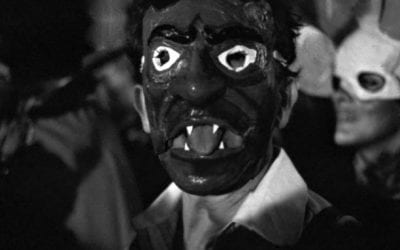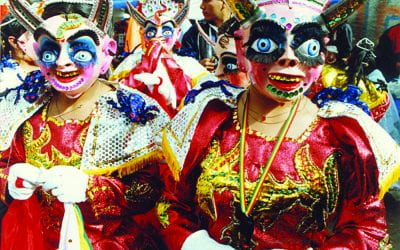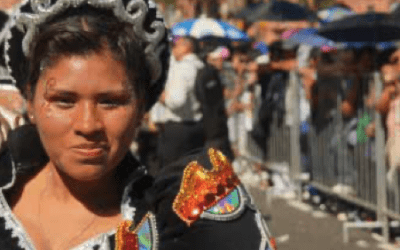Bodies and God
Rio Samba Schools and the Togolese Black Divinities Festival

The Togo photos of celebrating girls suggest the combination of ritual and entertainment also found in Rio’s samba. Photo by Yara Ligiéro
When watching the Festival des Divinités Noires in Togo in 2011 I was reminded of the images of samba school parades, which I’ve researched in Rio. Even though Rio’s carnival has become a mega multimedia event while the much smaller African festival retains a more artisanal organization, it resembled the old forms of the earlier carnival parades in Rio’s early 20th century, when they were exclusively organized by communities of African descent in their own particular way. I began to be curious about that history and also to establish commonalities between these two celebrations, observing how they both deal with the question of ritual, the body of the performer and its meanings today.
African or sub-Saharan traditional dances are characterized by both explosive and concentrated movement, total body involvement in tune with percussion, generating a context whose meaning is strongly spiritual and reaches, in ecstasy, a trance that represents the ultimate encounter with the divine. This may or may not occur depending on the type of ritual and the priest’s preparation. African dances—countless in their styles—vary with ethnicity, environment and mutual exchanges through migration. In these cultures, rituals take place in arenas, processions or both. The dance always occurs within a celebratory ritual context—a large capacity for interactivity and audience participation with mostly people from the same group or guests and supporters. Ethnicity speaks through the body in its own lexicon of articulated movements with rhythms and songs that are emblematic of the group’s own mythology or concerned with its identity.
I agree with African philosopher Bunseki Fu-Kiau that dance is only one element of African performance and should not be studied separately. He proposes the study of a single compound object—(“tied”) “drumming-singing-dancing”—a continuum. He also observes that when someone is touching a conga drum or any other instrument, a spiritual language is being articulated. Thus, we can understand that the classical separation between religion and entertainment does not apply in most African and their diasporic performances; they are complementary parts of the same celebration as I experienced personally in these two festivals in Rio and Togo.
The drumming-singing-dancing that characterizes the celebrations of Black Africa as seen in the Festival des Divinités Noires in Aného, Togo, as well as in the American diaspora in the Samba schools in Rio, Brazil, highlight the ambivalent nature of both festivals. In both, ritual and entertainment are complementary, with dramatic and epic elements in their performances.
SAMBA, PERFORMANCE IN ALL CIRCUMSTANCES
I’ve studied samba performances in four quite flexible categories. Although they express historic transformation in the structure of samba, these categories should not be examined solely within a chronological framework. Coming from the oral tradition, they expand and retract and will reappear in another context without strict historical accuracy. “Samba-play,” “Samba-ritual,” “Samba-drama” and “Samba-epic” are settings designed to study the forms and functions of samba from their own communities. Since the beginning, religious and secular community gatherings for samba festivity almost always happened on the same day as part of an ongoing celebration.
In the category called “Samba-play,” including the use of samba as pure and simple game, we may list various forms of folkloric samba, such as samba duro (hard) or de pernada (kick) and, in some cases, traditional samba called partido alto.Here, a simple lyric incorporates proverbs, popular sayings, with onomatopoeia, a play on the words and rhymes, the mode for its deployment. Its function is playful exercise, whose practice of impromptu verses keeps skills sharp, challenging the samba master’s poetry.
“Samba-ritual” is closest to its ancestral form. Generated within a religious context, it has liturgical functions, a form of prayer. Similar to the “Samba-play”, its poetry is simple, as is its rhythm and melody. The “Samba-ritual” found in Umbanda and the other related rituals are even reminiscent of the old batuques (drums). Its circular and repetitive rhythm and devotion that induce the lyric, take the body of the dancer to enter the vibration that requires the entity to return to the living world, through trance or possession. Samba as a ritual retains the qualities of traditional African style of performance: repetition, recitation, symbolism, and use of idiophone—known as a vivid representation of an idea with sounds.
“Samba-drama” comes about when the samba master talks about his daily life. Until the ‘20s, samba masters worked only within their own black communities. But with the spread and success of Rio’s vaudeville and burlesque theatre, the expansion of the music and film industries, and the proliferation of radio stations and the labor market opened by casinos and nightclubs, new opportunities were created, even for black people. It was, however, the urban samba, created in Rio de Janeiro in the early 20th century, that became known to the world as the main form of Brazilian popular music, a further development of this form of samba in the ‘60s supplanted the name samba, then called “bossa-nova.”
The “Samba-epic” may be synonymous with samba enredo (samba plot). When creating the plot, samba composers seek an overview of the topic, listing the different elements that recall the historical trajectory of the hero to be honored or the significant events experienced by the subject of the plot. Currently, the function of the plot itself is mobilizing an imagination that is capable of visually supplying thousands of costumes, props and floats. The samba is also created by a songwriting team, so its fragmented narrative cohesion then becomes a kind of collage of different styles of samba, in which all the information is packaged to promote easy understanding and song assimilation, linking the intrinsic necessity of crowd participation in the parade of each school, with about 5,000 performers.
The carnival parade was developed over nearly a century; its final space, the stadium Sambadrome, was inaugurated fifty years after the foundation of the first school of samba of Rio, “Let’s Talk” in 1926. The transformation of the parade into a media event televised live across the planet popularized it in a thoughtless way. While confined to a suitable space, sponsored by the government and by large multinationals, the parade of the samba school still continues to be the most genuine of Afro-Brazilian inventions, the quintessence of their processional performances, a great fiesta turned into reality each year.
If in the beginning of the 20th century, Catholic processions inspired the samba schools’ parade, many transformations have occurred since then; the samba processions created their own cosmogonies placing black gods and goddesses as black terrestrial representatives of human destinies. African kingdoms are resettled in Brazilian lands, but add the pomp elements from European clothing like velvet, the ornaments in gold thread, the royal insignia. Through his body, the samba performer creates a utopia in the professional performance. In addition to having total freedom of body movement, everyone has the right to be king for one night—assuming that his kingdom is the powerful and inseparable trio of African performance: drumming-singing-dancing.
FESTIVAL DES DIVINITÉS NOIRES: RITUAL AND ENTERTAINMENT
The Festival des Divinités Noires that takes place during a week in Aného-Glidji, a Togolese shrine, every two years, is one of the most spectacular of black Africa. The festival schedule varies each day with a wide range of performances, which merge the rituals of different religions from distinct regions with performances from Europe and the Americas. Conceived as a festival of heterogeneous dance traditions, it brings together groups of religious initiation associations, groups of traditional African dance, and dancers who bring their solos, sometimes mixed with contemporary dance styles. The performances that come from other continents are artistic, but those groups from black Africa come to perform their old dramas, bringing their ancient ancestors back by using “drumming-singing-dancing.” From inside the performance, the unwavering faith of individuals belonging to distinct traditions incorporates their local ancient deities indistinctly called “voodoos.”
At the opening of the festival at the shrine of Glidji the priests of the sacred forest Glidji perform a ritual alluding to the 41 voodoos brought from the Ghana region by the founders of the ancient kingdom of Togo in the 17th century. Afterwards, they have the parade of the main groups that will perform throughout the week of the festival. It is reminiscent of the samba schools’ old system of parade before the construction of the Sambadrome, when it had been staged in the streets of downtown Rio de Janeiro. The parade lasts for a few hours. Among the groups, two, comprised solely of young women and girls, attract the most attention: Virgins from Bazaar and Virgins Adjifo expose the nude female body just as in Rio. However, in Africa they are part of an ethnic ritual while in Rio it is pure show business. Two narrators take turns giving names and some details of each group as they are presented, in French and the local language, Ewe-Mina. They provide us with some elements of the complex plot performed by the groups of priests, believers or artists who come from different traditions bringing different types of instruments and characterizations. The structure of the procession is very close to the samba schools’ parade—first a small group enters the space with flags and banners identifying them as a delegation; then the singers and drummers reach the small stage at the entrance of the arena and begin to sing and play. One or more groups of dancers proceed to the center of the arena, where they perform their most complex evolution. The space of the main town square is transformed into a large arena for the presentation of the groups. On one side a large grandstand is mounted for a general audience and in the background there is a tent set up for the chief priests.
On the second day of the festival, the groups perform on a large stage specially mounted in front of the beach in Aného, and its structure more closely resembles that of a musical show. Two of the groups deserve special attention because they relate to Afro-Brazilian performances.
The first is the traditional dance group Amlima, composed of drummers, acrobats with stilts and singers, following the structure of procession. Some performances featured dancers with masks, props and flags. The group sings throughout the presentation and many of them take turns playing musical instruments with mastery.
The Goro Voodoo presentation is itself a spectacle. The strong and dramatic faces, marked with white dashes on black skin convey something mournful and eerie, but at the same time some of these characters like to play and pose. Sometimes they demonstrate being strong warriors; others show no fear of death by using their knives and daggers against their chest in a sequence of big hits. They traditionally come from Ghana but venerate entities from several neighboring countries, including some traditions of the ancient Hausa, who were converted to Islam in the 11th century: their clothes still resemble Muslim costumes. Some deities mentioned here are the spirits of “people who were sold” in Ghana, Togo and Benin, who for one reason or another were not shipped to the Americas but were enslaved by the local tribes of Ewes. Other legends say they suffered a violent death shown in their dances through violent gestures made by striking their chests with a knife, alluding to the ancient drama of their tumultuous passage to the other world. Past lives, revived, are recalled in a performance, a theater of spirits for the believers to understand their own ancestries through collective catharsis and ritual dramas.
Whoever sees the festival of black deities or watches the parade of the samba school for the first time is struck with the wonder of music and dance, the extraordinarily elaborate costumes with pictorial elements alluding to the very plot of the story they tell. Even those who are not from the black community, or who are not researchers, even those not able to understand the story in the plot, engage in spectacular environments, where the artist, beyond “drumming-singing-dancing,” embodies the history of the deities. As observed by New York University Professor of Performance Studies Richard Schechner, ritual and entertainment are performed simultaneously. While the Rio de Janeiro samba is strictly timed, Togo has an improvised schedule and long delays between presentations. However, even with the physical separation marking their evolution and the difference in the organization and structure of these events, the links between them are evident. Through a common ancestral literature, these two festivals preserve strong parallels in terms of aesthetics, faith and joy, commonly associated with Africanisms.
Spring 2014, Volume XIII, Number 3
Zeca Ligiéro is a professor at UNIRIO in Rio de Janeiro, Brazil. He is also the coordinator of NEPAA, the center for Afro-Amerindian Performance Studies at UNIRIO. He is a Cientista do Nosso Estado through FAPER.
Related Articles
Colombian Devils
The devils from Europe and Africa arrived in Colombia and as soon as they encountered the indigenous devils, they happily got together to amuse themselves. They take advantage of any…
Whose Skin Is This, Anyway?
An African-American dresses as a Plains Indian, as if seen through the lens of Fellini, while Andean natives wear white masks and carry whips, pretending to be colonial overseers. Whites…
Making a Difference: A Tale of Two Centuries
Harvard’s ties to Latin America go much farther back in time than 1994, the year that Neil Rudenstine and David Rockefeller launched the David Rockefeller…




